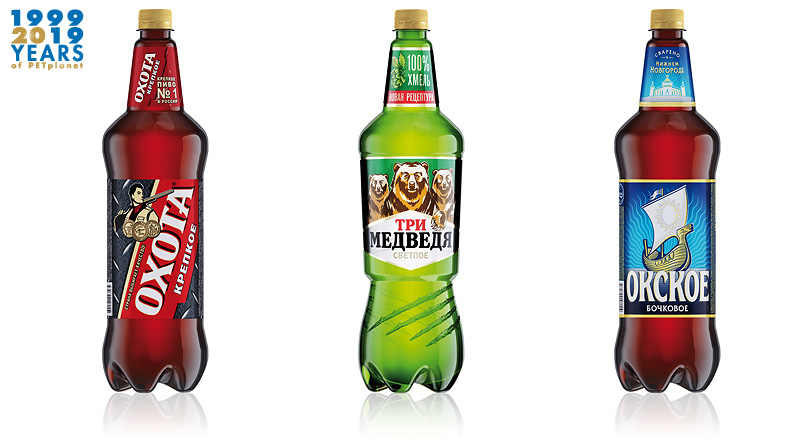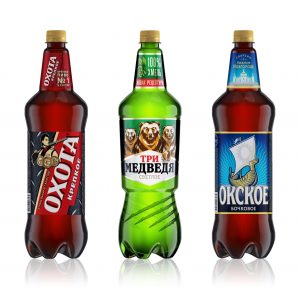Future trends in PET bottle processing
After looking back to the very beginning and some highlights of PET bottles, we also thought about future trends in PET bottles processing. We picked out some very new design and processing developments. Some topics come always in mind when thinking about PET bottle design today: less weight, the percentage of rPET and recyclability.
Two process developments in reducing weight of a PET bottle came from the company Redupet. First we would like to present Mint-Tec which is a new technology to mint the shape of the preform-base into its optimum design for the following blowing process. The effect is a significantly reduced wall thickness of the preform base, while the surface is increased. As the warmest spot of a preform after injection moulding is the base, it needs very little force to shape it to its optimum design.
Base optimisation
The special minting unit is shaping the conical or spherical base of the preform directly after injection moulding in the first heat. The minting unit is designed to use the reheat effect directly after the injection mould to decrease the wall thickness and to increase the outer surface of the preform through a gentle, but fast minting process. At the end of the shaping process the preform gets in contact with the cooling sleeve, were the cooling is very fast due to the reduced wall thickness and the increased outer surface.
There is no modification necessary of the existing mould, only a core change is needed for weight saving. The take out and transfer device of the preform production system needs to be replaced for existing moulds. The Mint-Tec device is mounted on the transfer plate of the injection moulding machine while the cooling sleeves on the take out device are delivering the counter design. Fast, precisely and without damaging the preforms, the Mint-Tec device is shaping the base of the preforms through the minting process.
Mint-Tec allows a saving of 3-5% of the total PET bottle weight. In the trend to less weight it extended surface and reduced wall thickness at the base. The injection and the blow moulding process are shorter. This patented technology leads to material- and energy savings.
Neck optimisation
The second place to reduce weight is the neck: Neck-Light technology allows to further optimise a modified preform-neck for the subsequent blowing process. The effect is a significantly reduced wall thickness of the preform neck, while the outer surface is increased. As a result, reheating in the blow moulding machine is far more efficient. To manufacture this kind of thin-walled neck area under the thread for flat and CSD applications especially developed melt-flow channels are installed to ensure a common injection moulding process while keeping the bottle quality at the same level. The thin-walled preform neck absorbs much IR light which means that stretch blow moulding is more efficient with a wider process window. The modification of an existing mould is possible by an exchange of the neck-splits. Neck-Lite is part of the injection mould. Thanks to especially designed channels in the neck splits the hold pressure is maintained in the neck thread during the moulding process. This prevents the otherwise feared sink marks in the precise neck area. With this technology 2-3% weight is saved.
An example is given: a preform of 10.5 g for 0.5 l of still mineral water with 128 cavities of Neck-Lite design has an effective weight reduction from 10.5 g to 10.2 g = 0.3 g per perform. 208 t of PET resin per year are saved.
Design: Clasper blow moulded bottle technology by PTI
This snap fit technology provides a unique packaging solution for food, beverage, pharmaceutical, nutraceutical, industrial, and household chemical products. The Clasper blow moulded PET bottle is available to brand managers pushing products in a package that requires two separate containers.
The Clasper double-bottle concept provides a solution for products that cannot be premixed or must be consumed in sequence, which opens the door for new product categories and creative product development. It gives consumers a unique usage experience, which is sure to delight.
Some features are including: a bottom container that can snap into the base of a larger top bottle. It has the ability to be blow moulded in various sizes. It can accommodate liquids or powders and is also available for hot fill applications. There can be a heat or induction seal for bottom containers with traditional closure for the top bottle and shrink sleeves can be used to promote branding and provide usage instructions. Typical markets for this Clasper blow moulded bottle technology are the beverage and food, personal and healthcare as well as the pharmaceutical market.
Deep Grip bottles
Deep Grip is an injection stretch blow moulding (ISBM) process to create a new type of container handle. Deep Grip technology enables significant grip depth with an extremely thin grip “web” thickness. The grip is deep enough for the average hand to completely close around without finger touching the container wall, providing comfort and handling ability similar to that experienced with a traditional handle.
Deep Grip development is one of the first commercially-viable handle processes that harnesses the advantages of ISBM and is ideally suited for commercialisation where clarity is desired. Compared to traditional extrusion blow moulding, ISBM enables lightweighting, higher output per cavity, mechanical benefits, and smaller equipment footprint.
Bottles taking advantage of the Deep Grip technology are made in a two-step process. The first step is conventional stretch blow moulding, which is then followed by a proprietary secondary operation within the same machine that forms the handle. This process is applicable to a broad range of ISBM bottle polymers, including PET, high density PE, biaxially-oriented PP, polylactic acid, among others.
Because the container and handle are made from the same material, it eliminates downstream recycling issues and contributes to lightweighting objectives. Lightweighting is possible because the grip geometry also provides structural benefits, which enable a reduction in bottle gram weight.
Target markets for this technology include detergents, household cleaners, non-carbonated beverages, milk, edible oil, motor oil, baby bottles, and other segments where handles are common. It is an ideal option for brand owners looking to drive weight and cost out of containers, improve its environmental profile, and facilitate product differentiation.
Mould design: A single mould with many customisation possibilities
PET Engineering’s solution that makes clever use of inserts (ITM) allowed Heineken Russia to launch two new PET packaging. The new shapes for Heineken Russia, 3 Medvedya, one of the most well-known Russian brands, Okhota & Okckoe, are simple and equally eye catching and, at the same time, offer a great flexibility, thanks to the fact that the aesthetics and format can easily be modified using interchangeable inserts: this means it is always possible to apply new decorations, to move and resize the label area and, to alter the capacity of the bottle, a very important aspect for future possible down-sizing to 1.3 l and 1.25 l formats.
A single shape able to create infinite variants is useful in case of introducing new SKUs to the portfolio, with low implementation costs. There is no need to buy new mould sets, may one want to revamp the image of a product but just simple inserts, generating a saving that is more significant as bigger is the number of alternatives implemented. Despite alterations to the bottle’s general appearance, expensive interventions to change formats on the production line will no longer be necessary.
The 115 sets of moulds supplied (1 set = 1 mould + 2 inserts), for 7 Russian factories, were equipped with lighter, lub-free composite components and treated for a greater durability with the application of the ceramic coating, ensure high wear resistance combined with a low coefficient of friction, bigger resistance to corrosion and an antibacterial and self-cleaning action.
PET bottle processing of the future – Voices from the industry
Robert Schiavone, Global Marketing Director at R&D/Leverage, USA:
“Bottles are being scrutinised as part of the whole ban on plastics movement grows. There have been plastic bag bans as you know; now one state here in the US has also banned bottles… So no doubt the future of the bottle is going to be more about raw material selections and innovative properties of raw materials that are allowing for a streamlined recyclable end use… As big box stores also begin to clamp down on the use of plastics and sustainability – the challenge is real and we will see more of this as the years go on.”
Sacmi Imola S.C., Italy:
“The bottle of the near future will be produced using PET from renewable sources; bottles will incorporate large proportions of recycled PET, in some cases up to 100%. The reasons for this will be a mix of new legislation coming up and brand owners social reasonability. This large use of recycled PET in new bottles will be possible because brand owners and designers will follow guidelines and certain criteria during the development phase of a new product, in order to facilitate PET recycling. These fore-thinking decisions will allow recycling PET bottles back into high-end applications, such as bottles. The market players will spontaneously decide to limit the colour of the bottles to clear PET or light blue, and most of the marketing messages will be conveyed via easily separable labels and labels not as big as to impede reliable automatic recognition at sorting plants.
The trend towards light weighting will continue for single use bottles, while more markets will embrace the use of returnable bottles, which will have the required strength and solidity to resist up to 15-20 filling cycles.
Bottles will be designed for ease of handling and consumer convenience, not to convey marketing messages, which often are not relevant for the real users of the packages. Marketing wise, this would be sustainable as the buying decision making process is expected to be shifted from actual shelves to on-line platforms, as e-commerce volume of fast moving consumer goods (FMCG) is expected to rise steadily.”
Sipa, Zoppas Industries Group of companies, Italy:
“The best of PET is yet to come: it’s crystal clear that PET will keep its leading role worldwide, to water populated megalopolis and remote rural areas. We need to consider that it would be utopian to live without plastic, at this point. Plastic itself is not the evil. Evil is the misuse and lack of information, education and attitude in plastic littering.
Public opinion against plastics is helpful, though, to boost PET recycle: and we believe in virtuous bottle-to-bottle to avoid downgrade of our beloved high-value macro molecule. It’s an obliged way to recover single use bottle (average usage time: 30 sec) to prevent littering and rivers/oceans pollution as well as to lessen our addiction to oil.
We believe in circular economy, and we make it happen with Xtreme Renew, turning un-expensive post-consumer flakes in to food grade performs in one single cycle. This is the current macro trend, and it’s a great solution for our planet in PET. On top of this, we still continue to develop weight reduction (from 4 g single serve, to 20 l for HOD), together with refillable application (where heavy weight is compensated by longer lifecyle).”


